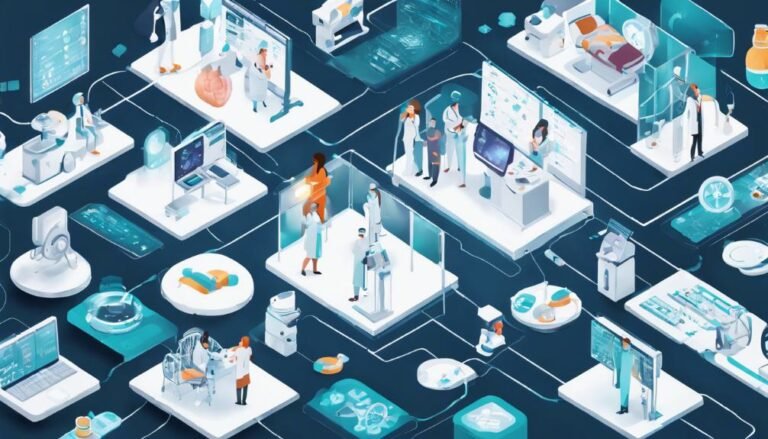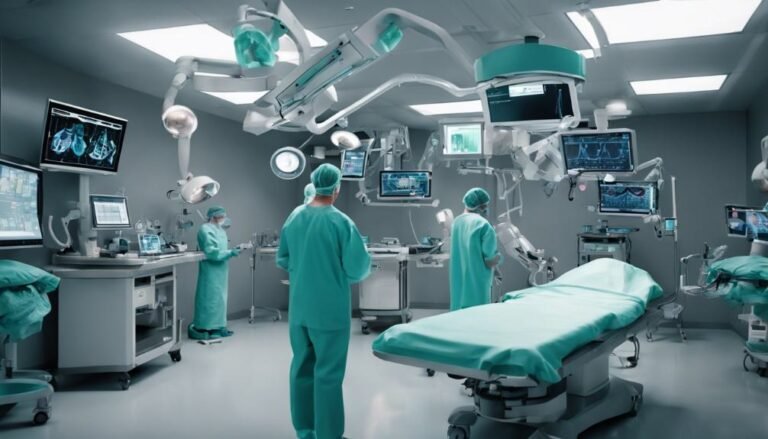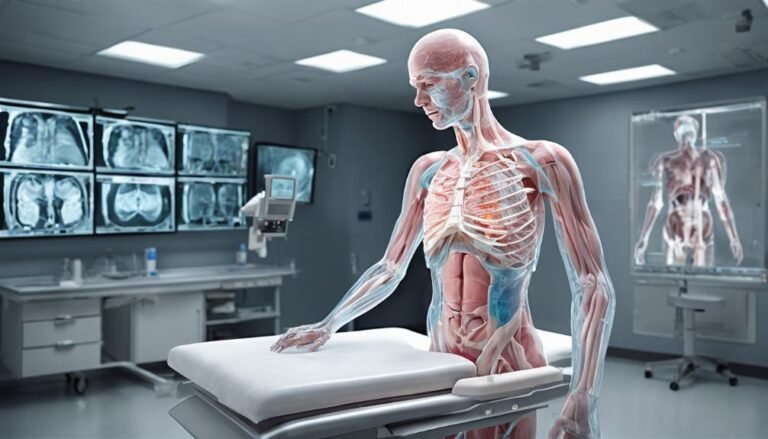AI in Medical Imaging: A Guide
As you explore the world of AI in medical imaging through this guide, you'll uncover a transformative landscape where technology intersects with healthcare. From revolutionizing diagnostic accuracy to reshaping patient care, AI's impact is profound. The guide offers a roadmap through the advantages, challenges, applications, and ethical considerations surrounding AI in medical imaging. Get ready to navigate the intricate web of innovation and responsibility that AI brings to the forefront of modern healthcare.
Key Takeaways
- AI in medical imaging enhances diagnostic accuracy and efficiency through advanced algorithms and deep learning.
- It streamlines processes, optimizes workflows, and reduces training requirements for medical staff.
- AI applications detect abnormalities, tumors, and medical conditions with high sensitivity.
- AI speeds up image analysis, leading to quicker treatment planning and personalized healthcare delivery.
- Future trends include machine learning advancements, integration with advanced imaging modalities, and promise of personalized medicine.
The Role of AI in Medical Imaging
AI plays a pivotal role in revolutionizing medical imaging by enhancing diagnostic accuracy and efficiency. Through the use of advanced AI algorithms, medical imaging advancements have reached new heights in recent years. These AI algorithms have the capability to analyze vast amounts of medical data with speed and precision, aiding healthcare professionals in making more accurate diagnoses and treatment plans.
By leveraging AI algorithms in medical imaging, healthcare providers can now detect subtle patterns or anomalies in medical images that may have been overlooked in the past. This increased accuracy can lead to earlier detection of diseases, ultimately improving patient outcomes and survival rates. Additionally, AI technology has the potential to streamline the diagnostic process, reducing the time it takes for patients to receive critical results and treatment.
Furthermore, AI algorithms can assist in prioritizing urgent cases, ensuring that patients with the most severe conditions are attended to promptly. Overall, the integration of AI in medical imaging represents a significant advancement in healthcare, offering a more efficient and effective approach to diagnosis and treatment planning.
Advantages of AI Technology
The utilization of advanced AI technology in medical imaging brings forth numerous advantages that greatly impact diagnostic accuracy and efficiency. AI offers substantial cost efficiency by streamlining processes, reducing the need for manual intervention, and optimizing resource allocation.
Workflow optimization is another key benefit, as AI algorithms can automate tasks like image analysis, allowing healthcare professionals to focus more on patient care. Additionally, AI technology can help in reducing training requirements for medical staff by assisting in image interpretation and analysis, thereby potentially improving overall productivity.
Moreover, AI systems can enhance data privacy by implementing robust security measures to protect sensitive patient information. By utilizing encryption and access controls, AI can contribute to maintaining compliance with data protection regulations, ensuring patient confidentiality. These advantages underscore the transformative impact of AI in medical imaging, offering a promising outlook for improving healthcare delivery and patient outcomes.
Challenges in Implementation
Implementing AI technology in medical imaging poses significant challenges that healthcare institutions must navigate to fully harness its potential benefits. One major challenge is ensuring data privacy. Medical imaging data is sensitive and must be protected to maintain patient confidentiality and comply with regulations like HIPAA. Healthcare providers must establish robust security measures to safeguard this information from unauthorized access or breaches.
Another obstacle is the training requirements for staff. Introducing AI systems into medical imaging workflows necessitates specialized training for radiologists, technicians, and other personnel. This training is essential to guarantee that healthcare professionals can effectively interact with AI tools, interpret their results accurately, and integrate them seamlessly into existing practices. Overcoming this challenge involves investing time and resources in tailored training programs specific to the AI solutions being implemented.
Successfully addressing these challenges is essential for healthcare institutions looking to leverage AI technology in medical imaging effectively while upholding data privacy standards and ensuring staff are equipped to maximize the benefits of these innovative tools.
AI Applications in Diagnostics
How can artificial intelligence revolutionize diagnostic processes within medical imaging?
AI applications in diagnostics leverage advanced AI algorithms and machine learning techniques to enhance radiology advancements. Deep learning, a subset of machine learning, plays a significant role in analyzing medical images with exceptional accuracy and efficiency. By utilizing AI algorithms, medical professionals can benefit from automated image interpretation, leading to faster and more precise diagnostic outcomes.
AI applications in diagnostics assist radiologists in detecting abnormalities, tumors, and other medical conditions with higher sensitivity and specificity. These technologies can analyze vast amounts of imaging data quickly, allowing for improved diagnostic accuracy and timely decision-making. Additionally, AI algorithms can aid in identifying subtle patterns or anomalies that might be challenging to detect with the naked eye.
The integration of AI in diagnostics not only enhances the efficiency of radiology workflows but also contributes to more personalized and effective patient care. As AI continues to evolve, its impact on diagnostic processes within medical imaging is poised to revolutionize the field, offering new opportunities for improved healthcare outcomes.
Impact on Patient Care
AI in medical imaging has revolutionized patient care by greatly enhancing diagnostic accuracy, leading to more precise treatment planning tailored to individual needs.
Additionally, the technology allows for faster image analysis, reducing the time patients spend waiting for results and enabling prompt interventions when necessary.
This overall impact on patient care signifies a monumental shift towards personalized, efficient healthcare delivery.
Enhanced Diagnostic Accuracy
With the advancements in AI technology, medical imaging has greatly improved diagnostic accuracy, leading to better patient care outcomes. AI algorithms are revolutionizing image interpretation, aiding clinicians in making more informed decisions. By analyzing vast amounts of data with incredible speed and accuracy, AI enhances clinical decision-making processes.
This precision in diagnosis allows for the implementation of precision medicine, where treatment plans are tailored to individual patients based on their unique characteristics and the specific details identified in medical images.
The increased accuracy in diagnosing conditions such as tumors, fractures, and abnormalities has a direct impact on patient care, ensuring that individuals receive timely and appropriate treatment. AI can detect subtle changes that mightn't be easily noticeable to the human eye, minimizing the risk of misdiagnosis and enabling earlier interventions.
As a result, personalized treatment plans can be developed, optimizing patient outcomes and improving overall quality of care in medical imaging.
Improved Treatment Planning
Improved treatment planning in medical imaging greatly impacts patient care outcomes by optimizing interventions based on precise diagnostic information. Through AI algorithms analyzing imaging data, treatment optimization becomes more personalized, tailoring medical interventions to individual patient needs. This personalized care leads to enhanced treatment efficacy and reduced risks of adverse effects, ultimately improving patient outcomes.
Faster Image Analysis
Improving the speed of image analysis in medical imaging has a profound impact on patient care by expediting diagnostic processes and treatment decisions, leading to more efficient healthcare delivery. Machine learning and deep learning algorithms play a pivotal role in enhancing the efficiency of image analysis. These technologies enable automated interpretation of medical images, reducing the time required for manual analysis and interpretation by healthcare professionals.
By swiftly identifying abnormalities or patterns within images, machine learning algorithms can assist radiologists in making accurate diagnoses promptly. The faster image analysis facilitated by machine learning not only accelerates the diagnostic process but also allows for quicker treatment planning. This speed is particularly vital in critical cases where timely interventions can greatly improve patient outcomes.
Additionally, the rapid analysis of medical images minimizes waiting times for patients, leading to expedited treatment initiation. Ultimately, the integration of machine learning and deep learning in medical imaging enhances the overall quality of patient care by streamlining processes and ensuring swift access to necessary treatments.
Future Trends and Innovations
Revealing the upcoming advancements in AI applications within medical imaging showcases a promising landscape of innovation and progress. In the field of AI in radiology, machine learning advancements are paving the way for significant breakthroughs.
One major trend on the horizon is the integration of AI algorithms with advanced imaging modalities, such as MRI and CT scans, to enhance diagnostic accuracy and efficiency. These AI tools have the potential to assist radiologists in detecting abnormalities more effectively and in a timelier manner.
Furthermore, the future holds the promise of personalized medicine through AI-driven imaging analysis. By leveraging vast amounts of patient data, machine learning algorithms can tailor diagnoses and treatment plans to individual characteristics, leading to more precise and targeted healthcare interventions.
Additionally, the continued development of deep learning techniques is expected to further enhance the capabilities of AI systems in medical imaging, enabling them to identify subtle patterns and nuances that may be imperceptible to the human eye.
As technology advances, the synergy between AI and radiology is poised to revolutionize medical imaging practices, ultimately benefiting patient care and outcomes.
Ethical Considerations and Regulations
Ethical considerations and regulations play a pivotal role in shaping the implementation and oversight of AI technologies in the field of medical imaging. Privacy concerns and data security are significant aspects that must be addressed when utilizing AI in medical imaging. As AI systems rely heavily on vast amounts of patient data, ensuring the privacy and security of this information is paramount to maintain patient trust and compliance with regulations such as the Health Insurance Portability and Accountability Act (HIPAA).
Moreover, legal implications and liability issues are essential factors that need to be carefully managed. The use of AI in medical imaging raises questions about accountability in cases of misdiagnosis or errors that may occur during the AI-assisted diagnosis process. Clarity on liability and legal responsibilities is crucial to protect both patients and healthcare providers from potential risks associated with the use of AI technology in medical imaging.
Conclusion
To sum up, AI in medical imaging is revolutionizing diagnostic processes, improving accuracy, and enhancing patient care.
Did you know that according to a recent study, AI systems have shown a 90% accuracy rate in detecting abnormalities in medical imaging scans?
As technology continues to advance, the integration of AI will play an essential role in transforming healthcare delivery and improving outcomes for patients.







